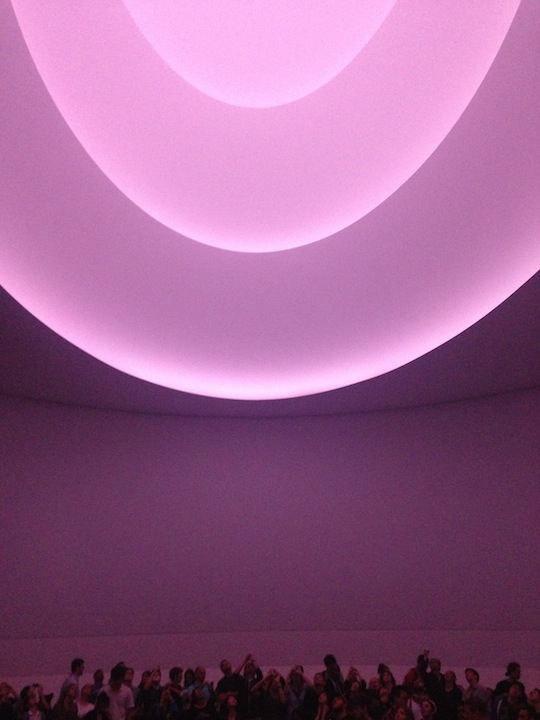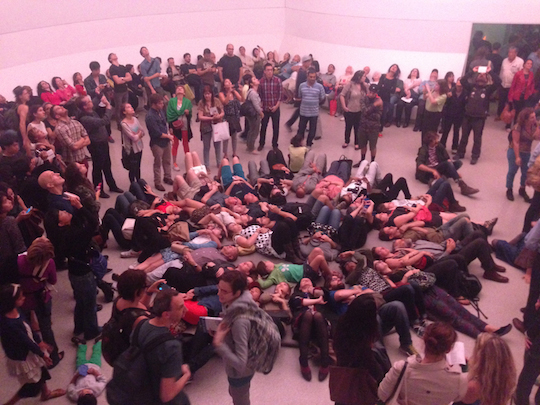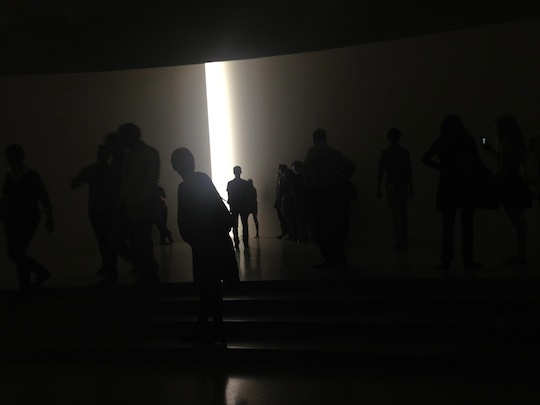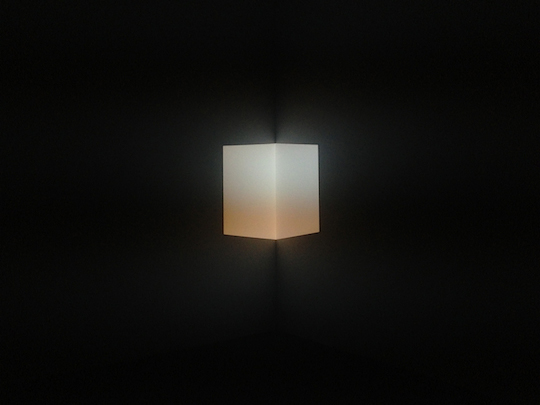The sun rises on the Upper East Side over the Guggenheim and Aten Reign (2013) breathes in the morning light. Its lungs are Frank Lloyd Wright’s concentric walkway spiraling upward toward the rotunda that inhales one color and exhales a different spectrum entirely. Casting the site-specific Aten Reign into the mold of Guggenheim’s open atrium, the central point of Wright’s iconic building, required one of the most dramatic physical transformations the museum has ever seen.
It’s midday in Houston on Sunday, September 22nd, and the Museum of Fine Arts says its final goodbyes to the exhibition that’s been up since June 9th.
The sun sets over the Pacific Ocean, and LACMA’s exhibition shines against a Los Angeles descending into evening.
I could go from day to night with James Turrell and the appropriate direct flights. I could lie on the floor of the Guggenheim and watch the spectrum of colors shift from the soft oranges of morning to the dark blues of night and walk back out onto 5th Avenue without knowing what part of the day it is. Everyone has seen or will see Turrell, somewhere. What I’m interested in is how it’s seen.
It all started last year when the Turrell trifecta was announced: three simultaneous exhibits of the light shepherd’s work, a perfect triangulation spanning the West Coast, Southwest, and East Coast. Four days after the opening at LACMA in May, there I was. I had driven out from New Mexico a few days prior for a Fleetwood Mac concert at the Hollywood Bowl (unrelated; it was perfect). I knew the Turrell retrospective was going on until April 2014, and I figured that all those who wanted to see it would evenly distribute themselves throughout that time, thereby making the number of people present on this particular day only a small fraction of the total. The math made sense. On a day already filled with Urs Fischer at the Geffen Contemporary (MOCA), I wanted LACMA to be the last stop. I wanted to abstain from seeing the exhibition until the late afternoon so that I could think about going all day up until then. I literally wanted to see the light at the end of the day. I wanted to hunger for it. I wanted to play the coquettish game of raising expectations, lowering them, and raising them again, in a flirtation with myself where I give in at the end. I waded through the congestion of Wilshire Blvd, growing impatient but also feeling like this was a kind of ritual sacrifice. I was paying my dues and putting in my time. Then, the traffic let me go, and I was free.
Sold out? My reply, “but it’s my birthday!” didn’t do anything except make me feel like an eight year old, begging for light instead of objects—but an eight year old nonetheless. My disappointment was visible; I looked sad enough for the cashier to offer free admission to the museum but not sad enough to get into the special exhibition I had come for. I remember looking at Magritte’s La trahison des images (1928-29) and feeling defeated by it. I was leaving the next day, and the time to come back didn’t exist. But I’d be in New York soon. I’d try again there.
A late-August arrival on the East Coast and one bustling month later, the September 25th closing date of Turrell’s exhibition at Guggenheim was approaching: a hard and fast deadline for the art runners who decided to walk instead of sprint to the finish line. With one week left, I isolated a few spots of perfectly clear calendar space. I didn’t want any obligations afterward, since I wasn’t sure what the side effects would be. Operating heavy machinery or being put in a situation wherein space and time regained priority—all of that was out. I wanted the unperturbed time to forget about time.
There was only one option in the space-time that led up to the final days before the closing: the last Saturday—Pay What You Wish night at the Guggenheim. Museum initiatives like this are goldmines for struggling students, who without these options face the dilemma of deciding between admission and half a basket of Trader Joe’s goods with more in it than empty sample cups. The decision hinges on a combination of appetite and desperation; purple light installation or purple grapes? It’s a palpable choice, but the prospect of using leftover coffee money to gain entrance into Wright’s sacred building and Turrell’s ephemeral universe was too tempting to pass up. It was a risky move going during the museum’s last hours opposed to earlier in the day, and I knew that. But I’d journeyed across the country since my last failed attempt, and if I didn’t get in that night, I’d be out of options. I left early, taking into account a propensity to get lost (I got lost), and resurfaced on the Upper East Side about twenty minutes shy of the 5:45 start time.
Heading toward the entrance, I noticed the line out the front door. Not yet intimidated, prepared with snacks and a book, I started for the end. Two ricecakes later, I had walked Madison Avenue and back up 89th Street to 5th Avenue only to find myself back at the entrance, which doubled as the end of the line going the other direction. People across the street started taking pictures of us, inducing a caged-zoo-animal feeling.
An hour later I wedged my bookmark between monologues and silently pleaded that the guy standing behind me would finally get off the phone with his mom now that I knew everything I didn’t want to know about infinity pools and breaking into the real estate market in Houston. I thought about the people who come into a yoga class with Bluetooths and stress still attached and who forget that the class won’t make their pent up emotions go away, and that they have to actively be a part of that process themselves. I knew this meditative space wasn’t going to just wash me in serenity; I would have to meet it halfway. I kept this in mind when I walked in, trying to focus and enter the present. I paid for my ticket with a tinge of shame, suppressing a strong desire to apologize to the girl at the counter, to tell her that I usually pay full admission, but right now I’m in graduate school, that I would definitely donate later—and then the light.
Aten Reign (2013)
Aten Reign is always changing colors but I won’t ever forget that first blue. A deep, bottom-of-the-ocean blue, which felt like the right analogy once I walked into the center of the ground floor and joined a sea of people looking up toward the light at the very top: that glimpse of sun just reaching down and illuminating us at the bottom. I’ve always liked that the Guggenheim invites you to take charge of your own museum journey. You’re generally venturing upward, yes, but with all the legroom and smaller exhibits along the way, there’s a true freedom to create your own itinerary, to stop when and where you want and for however long. There aren’t any IKEA arrows guiding you to the food.
But this felt different; a clear direction was needed to prevent chaos. You couldn’t be the salmon swimming upstream when everyone else wanted to go down. For the first time, I felt herded along a specific, delineated path that I never knew existed at the space. For a while, I tried ducking out of pictures but then gave that up. I was guided through Ronin (1968), a single light projection that creates a passage to an unknown place beyond its rays, and upward and onward toward Afrum I (1967) the piece I had most anticipated seeing. I stood there as long as I could. I stood until the time I spent apologizing and shuffling out of others’ ways outweighed the time I spent silently looking at light.
All this being said, I still loved the exhibit. It was soft, romantic, and challenging. Benjamin Backus, an Associate Professor at the Graduate Center for Vision Research at the SUNY College of Optometry, tells us:
One of the deep things about this art is it reveals to you…the fact that everything you see is constructed by your brain. In some very deep sense, everything you see is an illusion. What we experience are just mental representations.[1]
Turrell’s work isn’t just site-specific; it’s viewer-specific. By letting us see and engage with our worlds, light’s treated in the everyday as the means to an end. But because the light itself and not just what it can do for us was the point here, choosing to visit a museum to see it made me feel that it was supposed to be treated in a certain, sacred way.
Afrum I (1967)
I stayed for less time than I envisioned, and have certainly spent more time looking at a single painting. I could have lingered, but I stepped away when I felt the experience becoming compromised. There was no room on the beanbag apparatus at the bottom level for one more person to gaze up at Aten Reign, and the visitors’ camera flashes surrounding me started to make Afrum I look like a celebrity the paparazzi couldn’t get enough of. I wasn’t upset, but I did feel it was better to end the relationship right there when things were still pretty good, than to let it drag on until it self-destructed.
I left thinking, was it worth it? Not in the monetary payoff sense, but its ironic inverse: was it worth it to spend less?
I left Manhattan for Queens and placed a call to the Southwest to talk to someone who had recently seen the exhibition in Texas. He told me about a hot mid-week Houston morning and what it felt like to have the place to himself. I couldn’t stop wondering how different my visit might have been if I went that morning instead and gave up the extra $16. We drew on similarities but fell silent when trying to articulate certain obvious differences. His eyes adjusted to a light that mine didn’t have the time or space to see.
-Amie Zimmer































